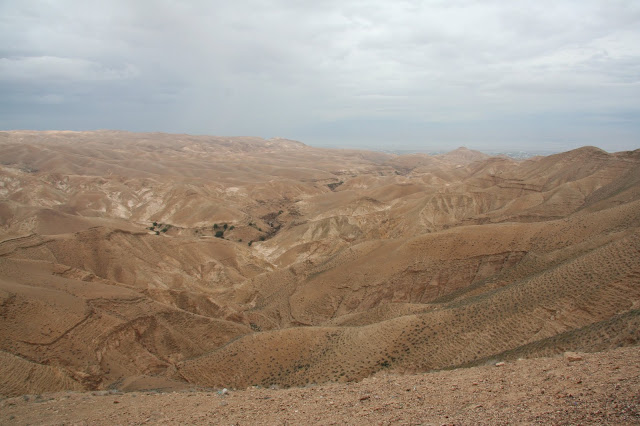Rare rainfall in the Judean Wilderness near Jericho.
John 1: 23: "I am the voice of one crying in the wilderness."
Judean Wilderness with Jericho and the Jordan River Valley in the distance. The green in the canyon is Wadi (valley/canyon of an ephemeral stream) Qelt.
https://upload.wikimedia.org/wikipedia/commons/6/61/Judean_Desert_Map.jpg
The Judean Wilderness (desert, sparsely populated area) outlined in red is a rain shadow. Storms come in from the west off of the Mediterranean Sea. A the storms rise over the Judean Hills, with Jerusalem at its crest, rain falls on the windward side (west side, called the Shephelah) due to orographic uplift. The leeward side descending from Jerusalem down to Jericho and from Bethlehem down to the Dead Sea is the rain shadow which gets limited rain during the winter months and little to no rain in the summer. Tradition has it that this is the wilderness where John lived. South of Jericho is Qumran, where the Dead Sea Scrolls were found and where John may have lived or associated with the Essenes who lived there.
https://water.fanack.com/palestine/climate-and-rainfall/
Precipitation amounts. Green more, red less.
https://bible.org/assets/netbible/map10.jpg
Wadi Qelt--a main canyon of the wilderness carved by winter rains that extends from Jericho up towards Jerusalem.
Notice the aqueduct. They were originally built to bring water from upstream springs to Jericho and done of Herod's palaces.
St George monastery (half way up the cliff side) in Wadi Qelt is one of the last remaining of many Greek Orthodox monasteries from the Byzantine Era that dotted the hills and cliffs of the wilderness.
St George Monastery. Some hermit monks prefer to live, as some did anciently, removed from others in caves like the one in the photo with wood railings and a bucket to raise and lower provisions.
En Gedi (Spring of the young goat)
Dead Sea in the distance
Four ibex clinging to the steep hillsides that rise above the spring and stream of En Gedi



From Qumran looking south to the Dead Sea and the steep drop of the Judean Wilderness into the Rift Valley.
Ruins at Qumran
Cave where the Dead Sea Scrolls were found.

A full day in the Judean Wilderness (Massada, Dead Sea, En Gedi and Qumran) can be hot and tiring for some.
https://www.sharefaith.com/blog/2017/07/the-sea-of-galilee/
Bethsaida, to the east of Capernaum, is located where the upper Jordan River flows into the Sea of Galilee.

Looking across the Jordan River delta to the Sea of Galilee.

Ruins of Bethsaida.
Shops on main street.
Further reading about Bethsaida--there are two possible sites: https://news.nationalgeographic.com/2017/08/jesus-bible-apostles-bethsaida-israel-archaeology/
https://www.biblicalarchaeology.org/daily/biblical-sites-places/biblical-archaeology-sites/where-is-biblical-bethsaida/
https://bethsaidaarchaeology.org/
John 1:46: "Can there any good thing come out of Nazareth? Philip saith unto him, Come and see."
Modern day good people of Nazareth:
John 1: 23: "I am the voice of one crying in the wilderness."
Judean Wilderness with Jericho and the Jordan River Valley in the distance. The green in the canyon is Wadi (valley/canyon of an ephemeral stream) Qelt.
https://upload.wikimedia.org/wikipedia/commons/6/61/Judean_Desert_Map.jpg
The Judean Wilderness (desert, sparsely populated area) outlined in red is a rain shadow. Storms come in from the west off of the Mediterranean Sea. A the storms rise over the Judean Hills, with Jerusalem at its crest, rain falls on the windward side (west side, called the Shephelah) due to orographic uplift. The leeward side descending from Jerusalem down to Jericho and from Bethlehem down to the Dead Sea is the rain shadow which gets limited rain during the winter months and little to no rain in the summer. Tradition has it that this is the wilderness where John lived. South of Jericho is Qumran, where the Dead Sea Scrolls were found and where John may have lived or associated with the Essenes who lived there.
https://water.fanack.com/palestine/climate-and-rainfall/
Precipitation amounts. Green more, red less.
https://bible.org/assets/netbible/map10.jpg
Wadi Qelt--a main canyon of the wilderness carved by winter rains that extends from Jericho up towards Jerusalem.
Notice the aqueduct. They were originally built to bring water from upstream springs to Jericho and done of Herod's palaces.
St George monastery (half way up the cliff side) in Wadi Qelt is one of the last remaining of many Greek Orthodox monasteries from the Byzantine Era that dotted the hills and cliffs of the wilderness.
St George Monastery. Some hermit monks prefer to live, as some did anciently, removed from others in caves like the one in the photo with wood railings and a bucket to raise and lower provisions.
En Gedi (Spring of the young goat)
Dead Sea in the distance
Four ibex clinging to the steep hillsides that rise above the spring and stream of En Gedi


Bedouin sheep off of the main road half way between Jericho and Jerusalem.

From Qumran looking south to the Dead Sea and the steep drop of the Judean Wilderness into the Rift Valley.
Ruins at Qumran
Cave where the Dead Sea Scrolls were found.

A full day in the Judean Wilderness (Massada, Dead Sea, En Gedi and Qumran) can be hot and tiring for some.
John 1: 43-44: "The day following Jesus would go forth into Galilee, and findeth Philip, and saith unto him, Follow me. Now Philip was of Bethsaida, the city of Andrew and Peter."
https://www.sharefaith.com/blog/2017/07/the-sea-of-galilee/
Bethsaida, to the east of Capernaum, is located where the upper Jordan River flows into the Sea of Galilee.

From the tel (hill) of Bethsaida looking south to the depression (also part of the Rift Valley) of the Sea of Galilee. Bethsaida was a fishing village at the time of Jesus but since then the Jordan River has extended its delta out into the sea leaving Bethsaida high and dry.

Ruins of Bethsaida.
Shops on main street.
Further reading about Bethsaida--there are two possible sites: https://news.nationalgeographic.com/2017/08/jesus-bible-apostles-bethsaida-israel-archaeology/
https://www.biblicalarchaeology.org/daily/biblical-sites-places/biblical-archaeology-sites/where-is-biblical-bethsaida/
https://bethsaidaarchaeology.org/
John 1:46: "Can there any good thing come out of Nazareth? Philip saith unto him, Come and see."
Modern day good people of Nazareth:


































No comments:
Post a Comment